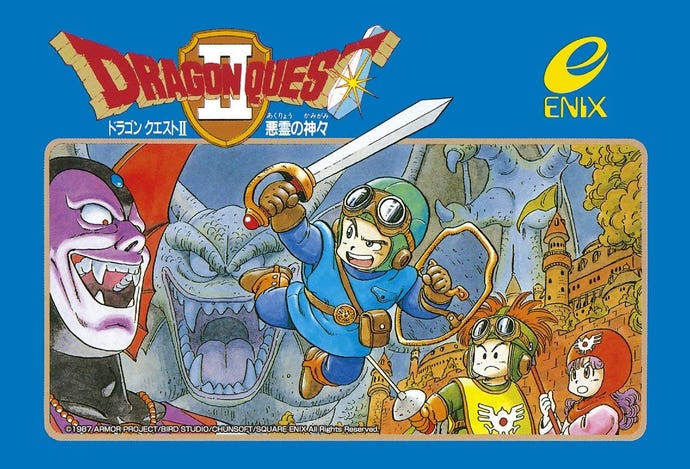Yuji Horii Remembers the Difficult Road to Liberating RPGs from Costly Computers With Dragon Quest
HISTORY OF RPGS | The great migration away from just PCs started with Dragon Quest in 1986.
This article first appeared on USgamer, a partner publication of VG247. Some content, such as this article, has been migrated to VG247 for posterity after USgamer's closure - but it has not been edited or further vetted by the VG247 team.
This is the fourth entry in an ongoing series by Retronauts co-host Jeremy Parish exploring the evolution of the role-playing genre, often with insights from the people who created the games that defined the medium.
The View From the East
The role-playing game initially emerged from the primordial soup of America's early academic computing systems. But the U.S. didn't have a monopoly on computers. By the time the ’80s arrived, every prosperous nation had not only its own high-end shared computing system for government and academic use, but its own local brands of humble, consumer-centric systems as well. Certain computing standards—processor families like the 8086 and 6502, or operating systems like DOS and ProDOS—tended to be universal, but the particulars of international computers were custom tailored to the needs of their respective markets.
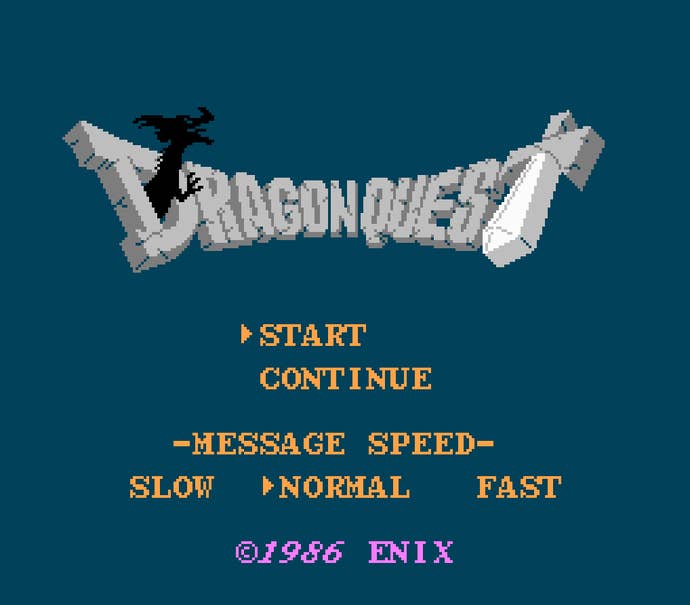
This proved especially true in Japan. There, the written language consists of a heavily modified and profoundly idiomatic variant on Chinese ideograms. QWERTY keyboard and single-character text entry systems developed for English-speaking regions didn't meet the needs of Japanese consumers and businesses. Electronic companies like NEC and Sharp were quick to fill this vacuum with a slate of PCs designed especially for Japan. Typically, these computers offered multi-character key-entry systems and enhanced screen resolution that allowed them to more easily handle intricate kanji text, and these tweaks made those systems quite distinct from western computers.
Perhaps this technological divide helps account for the appeal of imported role-playing games among Japan's tech literati in the early ’80s. In an era where simply owning a computer was something of a status symbol, RPGs must have seemed especially tantalizing. RPGs were stuffed with English text—something that had become synonymous with cool in ’80s pop culture in Japan—and the big international hits only ran on pricey imported computers. American PCs weren't entirely unheard of in Japan, of course; Satoru Iwata fell into Nintendo's orbit specifically because his experience with coding for Commodore's VIC-20 translated neatly to the NES, which ran on a similar processor. But those foreign computers and their games were rare, expensive, and inaccessible. For enthusiastic young computer nerds prowling the alleyway shops of Akihabara, that made for a heady combination.
Naturally, Japan's pioneering game designers were eager to try their hand at creating their own takes on the RPG. Many of these early works have been lost to time due to their meager distribution on computing platforms that never made their way to other countries, but clearly the interest was there. Still, the import giants reigned supreme. Japan's first true locally made RPG hit, The Black Onyx, was designed by Dutch emigré Henk Rogers (of Tetris licensing fame) in the style of Wizardry. Developer Nihon Falcom was so inspired by Ultima that it may have gotten in the way of a possible import licensing relationship with Origin Systems; legend has it that Richard Garriott was less than thrilled to find its hit Xanadu contained in-game art lifted directly from Ultima 3's manual.
It wouldn't be until 1986 that a truly unique and substantial take on the RPG emerged from Japan. Ironically, it wouldn't be a game designed for PCs at all but rather for consoles. But then, that's what made Dragon Quest so significant.

Lone Crusader
The original Dragon Quest seems, in hindsight, a rather paltry take on the RPG. Even a novice player can complete the entire adventure in less than 20 hours. The quest contains a whole two story objectives—rescue the princess and defeat the Dragon Lord—and technically you don't even need to bother with the rescue if you know the trick to reaching Charlock Castle, where the villain resides. Dragon Quest almost completely abandons the RPG party mechanics innovated by Wizardry and Ultima 3, putting players in control of a single character with a fixed skill progression path and a linear selection of gear upgrades to purchase. You have menu-driven, turn-based combat revolving around spells and swords, but even so, Dragon Quest is about as bare-bones as an RPG can be.
And yet, Dragon Quest existed. That alone made it remarkable: here was a pretty reasonable interpretation of the RPG, and somehow, it ran on Nintendo's NES console.
"We only had 64 KB of memory," says Dragon Quest director Yuji Horii. "We had to implement the system, the monster, data, graphics, story, and music—all of it into that cartridge. We were quite impressed that we were able to achieve that."
By comparison, most PCs in 1986 used 5.25" diskettes that offered 340 KB of storage, with a few early adopters already enjoying Sony's luxurious new 3.5" disk format with its stunning 720 KB of space. And unlike cartridge-based console games, computer software could span multiple diskettes or even install compressed data onto capacious hard drives. On top of that, the NES used a two-button controller, whereas PC RPG fans had already grown accustomed to making use of an entire keyboard to quickly input commands. An RPG should never have been possible under those conditions.
In sheer technical terms, Dragon Quest couldn't begin to compare in scope or complexity to a contemporary PC RPG like 1986's The Bard's Tale 2 or 1987's Wasteland. Somehow, though, Horii (along with programmer Koichi Nakamura, now president of Spike Chunsoft) managed to create a recognizable imitation of the RPG experiences that could be had on more powerful platforms. Even more impressively, Dragon Quest held up as a complete and satisfying (albeit compact) work in its own right, and in doing so it paved the way for an entire genre of games.
"With Dragon Quest, we were developing for the NES at the time—the Famicom in Japan—and I really wanted to bring the RPG genre to that platform," Horii says. "But we all know that the machine and the hardware itself was quite simplistic. It didn't provide a lot of space to do much, in that sense.
"Oftentimes people had mentioned that it would be impossible to bring RPGs to the system, but by creating and focusing on one character rather than a party, and then kind of simplifying various mechanics but still ensuring that people would still get the sense of fun and interesting aspects of an RPG game, we were able to successfully achieve it."
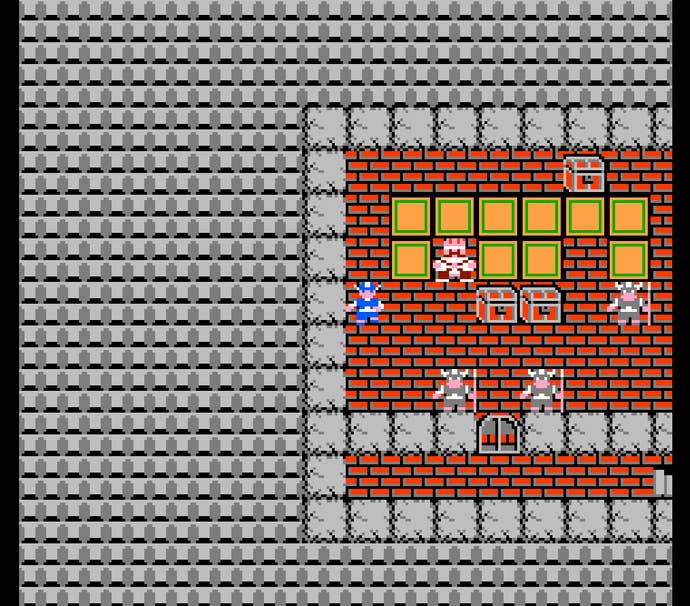
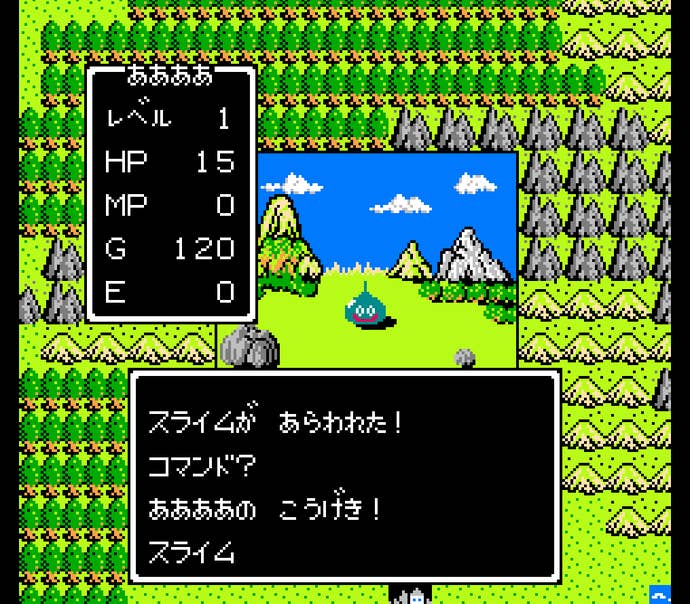
Dragon Quest reproduced the broad strokes of the role-playing genre. As with the formative works designed in the U.S., it took place in a generic medieval European fantasy land prowled by monsters and ruled by an evil wizard. The hero took up his quest from the king, slept at inns to heal, and battled foes with melee strikes and magical skills. Defeated monsters yielded gold and experience, and townspeople offered crucial clues for advancement.
Where The Black Onyx had directly lifted its mechanics and aesthetics from Wizardry, Dragon Quest attempted to do something a little different. Combat here played out through a Wizardry-style first-person perspective, but the hero explored the kingdom of Alefgard—both its expansive overworld and its murky dungeons—by way of a top-down viewpoint reminiscent of Ultima. What really set it apart from its peers, however, was its visual style. Dragon Quest pitted players against ravening fantasy monsters and spell-slinging undead, but it avoided anything resembling realism. Instead, the game embraced both its young audience and the colorful graphical capabilities of the NES hardware by rendering bad guys as whimsical cartoon characters illustrated by a rising star of comic art by the name of Akira Toriyama.
At the time, Toriyama was a year or two into his decade-long run on Dragon Ball, the follow-up to the extraordinarily popular comedy manga Dr. Slump. His involvement with the game became a huge selling feature, though Horii admits it came about through sheer circumstance... and perhaps just a bit of chicanery.
"Given the fact that it was on the NES, we wouldn't really be able to achieve a truly realistic imagery or graphic style. At the time, I was a writer for [manga magazine] Shonen Jump, and my editor was actually the same editor for Toriyama-san. The editor had mentioned something to the effect of Toriyama-san really wanting to work on a game, and that's how we got into it and brought Toriyama-san on board to create the designs.
"In retrospect, it turned out that Toriyama-san never really had an interest [in games] or anything. It seems like the editor was just trying to incentivize him!"
Dragon Quest may not have been Toriyama's dream project after all, but he nevertheless brought his A-game to the project. His interpretations of standard RPG monsters looked like nothing in any other video game before it, projecting whimsy and menace in perfect balance. Practically every foe you encountered in Dragon Quest faced off against players with a smile plastered on its face, but Toriyama's masterful pen covered a spectrum of expressions. Silly grins for low-tier monsters became wicked smirks as you reached the upper echelons of the monstrous ranks. It also helped that Toriyama knew when to switch things up for effect; several foes that appeared as de facto bosses—the guardian Golem and deadly Axe Knight—loomed over the player with blank expressions that seemed all the more menacing for the goofiness surrounding them.
Of course, you'll find the pinnacle of the Dragon Quest/Toriyama connection in the game's lowest-level enemies, the humble Slime. An RPG standard, other games had rendered Slimes as formless puddles of ooze or else as gelatinous cubes containing the acid-eaten remains of hapless adventurers suspended within. Toriyama's Slimes, on the other hand, were colorful onion-shaped blobs peering up at players with wide eyes and gormless grins. They came off as a combination of the gels from Namco's Tower of Druaga (a Pac-Man-inspired action RPG that had been a massive hit on Nintendo's Famicom the year before Dragon Quest's debut) and Toriyama's own popular, multi-colored Poop Boy sight-gag characters from Dr. Slump. The Dragon Quest Slime became an instant icon and has been reworked into literally dozens of alternate forms, ranging from timid Marine Slimes hiding in their spiky conch shells to the elusive, deadly Metal King Slime (worth a fortune in experience... if you can defeat it).
Toriyama, whose comics tend to have a playfully naughty undertone, probably has something to do with Dragon Quest's bawdy humor, too. Girls in bunny costumes populate the series' casinos, and you can pay women to perform the mysterious act known as "puff puff" in many of the games. Even the original Dragon Quest, limited as it was, managed to squeeze in a little playful ribaldry. If you stopped to rest and heal up while leading the rescued Princess Gwaelin back home, the innkeeper would make a sly comment the following morning. Truly, Dragon Quest fell far from the staid adventures that inspired it.

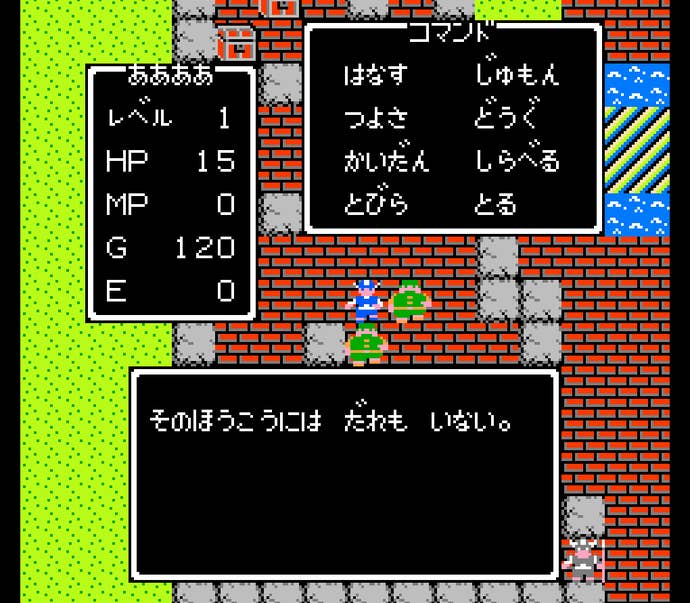
Corporate Crusader
One other critical factor set Dragon Quest apart from the formative RPGs of the prior decade: it had corporate backing. Where Ultima, Wizardry, and even The Bard's Tale represented the work of determined amateurs who were making things up on both the design and business level as they went along, Dragon Quest's creators had plenty of experience under their belts by 1986. They also had the support of an established publisher.
Japanese publisher Enix had entered the computing biz at the dawn of the ’80s and quickly turned its focus to gaming. Enix itself didn't create many games, however. Instead, it worked more as a pure publisher, shepherding promising projects to market. Both Horii and Nakamura got their breaks thanks to Enix's talent search contests, which picked up contest entries by both men (sports sim Love Match Tennis and puzzle-platformer Door Door, respectively) and brought them to retail in Japan. Both designers remained in Enix's orbit, with Nakamura's own company Chunsoft working as a go-to contractor to help facilitate Enix's projects.
Working under Enix's umbrella, Horii and Nakamura benefited from opportunities that would otherwise have been impossible. For example, the Enix connection is responsible for Dragon Quest's iconic musical themes. Composer Koichi Sugiyama "responded to a survey," says Horii. "Our producer read that survey, and that's how Sugiyama came on board in the production process as well." Although Sugiyama has become a decidedly controversial figure in recent years, there's no denying that his soaring compositions have become an inextricable component of Dragon Quest.
Enix also opened the door to the NES. The company had been one of Nintendo's earliest third-party supporters, and they shared a close relationship with the notoriously thorny console giant. Although Dragon Quest could have been a far grander game as a PC release, Horii wanted to reach the console's much larger market. To that end, the team even settled for a bare-bones cartridge release rather than aiming for the system's new Disk System expansion, which offered far more memory than a standard cart. "I felt like having to buy an additional system was a high barrier to a certain degree," say Horii. "So we wanted to ensure that everyone could play on the Famicom alone and enjoy the game on [the standard hardware]." While this made for a comparatively tiny game that lacked save support (players had to record their progress by jotting down lengthy passwords on paper), their gamble paid off when Dragon Quest ended up selling 1.5 million copies—a massive figure by the era's standards.
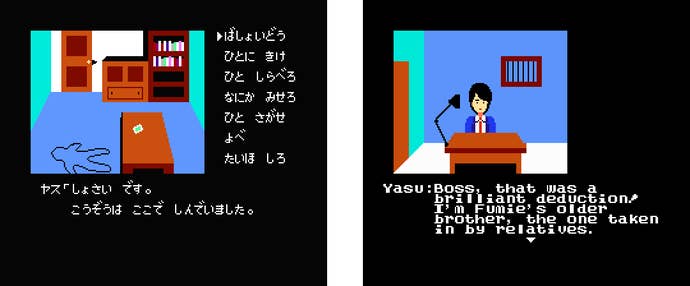
Enix's publishing and marketing support played a huge role in Dragon Quest's success, but ultimately the game worked because of its singular focus on bringing role-playing to a console. Horii and Nakamura were both fans of those elusive western RPGs that were all the rage in the early ’80s. ("Wizardry was quite popular back then, so I purchased that, and it was my first experience," recalls Horii.) But Dragon Quest's mechanical and interface design owed a great deal to Horii's first big hit, a graphical adventure whose title translates to The Portopia Serial Murder Case.
The graphical adventure genre as a whole could be seen as a close cousin to the RPG. They owe their existence to Infocom's Zork, itself an adaptation of tabletop role-playing experiences. Zork focused on the narrative exploration of pen-and-paper campaigns instead of the combat elements that fueled Wizardry, and formative games like King's Quest drew the genre further and further from those roots. Still, the similarities between the mystery-driven Portopia and the more adventuresome Dragon Quest make the two genres' relationship explicit.
"Originally, I wanted to actually become a manga artist," says Horii. "I really liked developing and creating stories. With computer games, I found this whole new level where you have interactivity and interaction and could progress your stories in that fashion. I developed an adventure game, The Portopia Serial Murder Case, and after that I discovered the RPG.
"It was quite niche back then, and oftentimes, people didn't quite know what to do in the games. We wanted to create a kind of linear rail that people can go on to experience the genre. Furthermore, in Portopia, I had implemented a command system where you were able to select your moves and whatnot, and that had naturally carried over to the Dragon Quest games as well."
Portopia had debuted as a computer title, but it was soon reworked for Famicom. As detailed in Nathan Altice's I Am Error, the move to a platform reliant on tile-based graphics and controller-based inputs forced Horii to rethink the mechanics of his adventure game from the ground up. The simple window-based menu command system he developed for Portopia's Famicom release became a foundational component of Dragon Quest.
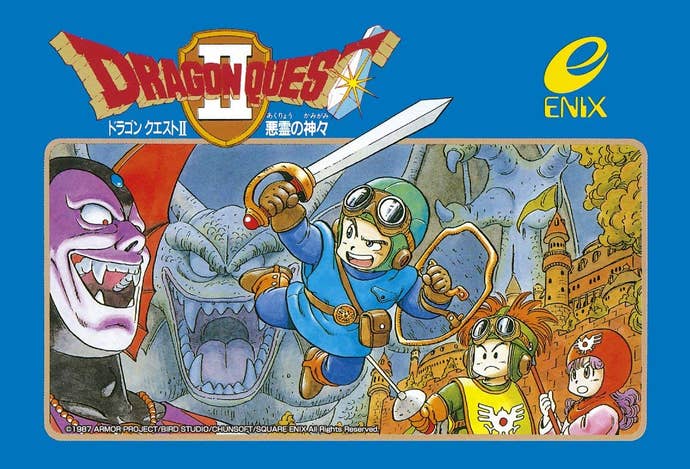
A New Hope
Ultimately, Dragon Quest saw the role-playing genre entering a new, mature phase. Despite its bright, cartoonish art and simplified design, Dragon Quest was a sophisticated work. It brought together elements of multiple genres, an interest in storytelling, and the need to work within the harsh constraints of a limited platform. The end result had broad appeal, reaching a mass audience of young and casual players who previously had been locked out of RPGs due to their complexity and the costly platforms that powered them. And this, Horii says, was entirely by design.
"You know, oftentimes video games and computers in general, they can feel quite cold, right?" muses Horii. "With Dragon Quest, we're always aiming to create a very kind of warm environment, a warm world, within the game. That's carried over throughout all of the different genre games within the Dragon Quest series, as well as bringing the unexpected and keeping the excitement alive."
Dragon Quest's success ensured the quick arrival of both sequels and imitators. Single-player RPGs designed conspicuously in Dragon Quest's shape glutted the Famicom and other consoles throughout the late ’80s and into the ’90s. These varied wildly in quality, but the best of the bandwagon-riders resulted in long-running franchises including Final Fantasy, Shin Megami Tensei, and Phantasy Star. Meanwhile, Dragon Quest's own sequels built progressively on the last, growing in substance and quality at such a pace that the original game soon felt more like a primitive rough draft than a proper standalone release.
"With Dragon Quest II and III, you know, the memory space limitations had doubled or tripled," says Horii. "So of course what we could do within the game also expanded and in line with that, and so we were able to kind of further build on that."
Dragon Quest II added additional party members to the mix, making for a quest that felt more like a proper role-playing adventure than its lonely predecessor. Two years later Dragon Quest III arrived; with its massive world and highly involved class-change system, it became, in effect, the de facto template for the console RPG. The goal for sequels, according to Horii, has always been to take the series one step further than the last.
"With Dragon Quest III, for example, we had a party with companions," he says. "But then I realized that each of these companions also have a life of their own. That's why with IV, I wanted to create a story that also told the lives of the companions and made an experience that revolved around kind of bringing each of those party members together. With V, we wanted to depict the life of a single character, from his childhood to adulthood, and then you see his son becoming a hero himself."
More than any other RPG series, Dragon Quest has managed to stay true to its roots. You can play Dragon Quest XI and see the clear through-line to the original NES game: its audio elements, monster designs, spells and weapons, and even the intangible feel of the adventure itself hearken back to the 8-bit days. Horii and his co-creators seem never to have lost sight of the fundamentals of Dragon Quest. And why should they want to? The original game perfectly reinvented a genre for a format and audience that RPGs had never catered to before. That's rare alchemy.
